Did you know that 17 percent of your customers could walk away from your business after just one bad customer experience? That’s a pretty significant number, especially when you’re trying to grow your business and increase your return on investment (ROI).
There’s good news, though: You don’t need to lose these buyers if you prioritize the customer experience. Below, I’ll explain what customer experiences are, why they matter, and how you can optimize your customer experience online.
What Are Customer Experiences?
Customer experience (CX) is how customers perceive any interactions they have with your company. It’s the overall impression of your company that customers build as they move through each stage of the buyer’s journey.
Think of it this way. Each time a customer interacts with your brand, even if it’s only a brief interaction, they’re building an impression of what it’s like to do business with you. This impression determines, for example, whether they’ll shop with you again or recommend you to friends.
In other words, positive (or negative) customer experiences can directly impact your bottom line. Got an unhappy customer? They might abandon their cart or never shop with you again. Got a happy customer? They might recommend your services to a family member.
Actions that can shape the customer experience include:
- calling your help center
- paying a bill
- tweeting you with a query
How important is CX, though, in real terms? Very. Let me show you why.
Why Is Customer Experience Important?
For one thing, it’s hard to grow your business without customers. They’re central to everything you do. However, if you’re still not convinced CX matters, here are a few more specific reasons why the online customer experience is so important:
- Customers are more likely to stay loyal to brands offering great CX. Given that 65 percent of a company’s business often comes from existing customers, delivering a great experience can help you work on that all-important retention rate.
- When a customer has a great experience, they could leave a review online, which encourages others to try your business. According to ReviewTrackers, more than a third of individuals reading reviews only look at businesses with four or more stars, so great CX can help you boost your visibility.
- The better the experience, the less likely customers are to abandon your business in favor of competitors. In other words, CX can directly affect your churn rate.
The bottom line? Happy customers are more likely to spend more, stay loyal, and recommend your brand to others. If you’re keen to boost your ROI, it pays to work on customer experience optimization.
What Do Most Businesses Get Wrong About Customer Experience?
Customer experience optimization can be challenging to get right, especially if you approach it all from the wrong angle. To help you avoid making time-consuming (and potentially costly) mistakes, here’s what businesses often get wrong about CX.
Ignoring CX
It sounds obvious, but the biggest mistake businesses make is ignoring CX completely. Why? Because customers care about their experience. In fact, four out of five people would abandon a brand after fewer than three negative experiences
Ignoring CX could damage your customer retention and even limit your ability to attract new business.
Failing to Track Metrics
Even if you do care about customer experience optimization, you’ll never know how you’re doing without tracking your performance. I’m going to touch on the best metrics to track later, but here are some key questions that performance data can help answer.
- How many customers stop doing business with you?
- Would customers recommend you to friends or family?
- How easy is it for customers to resolve issues or queries?
By tracking customer experience metrics, you can optimize CX at every stage of the buyer’s journey.
Using Impersonal Communication
It’s not uncommon for businesses to treat customers as a whole unit rather than an online audience made up of multiple individuals. The issue? Well, personal communication matters: Impersonal communication won’t drive growth.
- According to McKinsey research, 71 percent of customers expect personalized interactions from businesses.
- What’s more, fast-growing companies see at least 40 percent of their revenue coming from personalized messaging.
If you treat your customers as numbers, they could look elsewhere for the personalized CX they want.
Neglecting to Train Employees
Sure, it’s important to build a user-friendly website and make it easy for buyers to shop with you, but the customer experience starts with your staff. What’s a common mistake companies make, though?
Failing to train their employees in the art of customer service delivery.
Customers come to you looking for a shopping experience. If your staff don’t have the knowledge, experience, or authority to resolve customer issues, then you’ll frustrate your shoppers and they could turn to your competitors instead.
Now you know what not to do, there’s still one question remaining: How do you actually improve CX to boost your revenue? Let’s take a look.
5 Ways to Improve Customer Experiences and Increase Revenue
While there are multiple ways you might drive revenue by optimizing customer experiences, here are my five favorite strategies.
1. Find Out Where You Stand
Before you can perform customer service optimization, you need to know what’s working right now by tracking key performance indicators (KPIs.)
You might already be familiar with tracking KPIs as part of your wider marketing strategy. However, in terms of measuring customer experiences, here are some metrics to track:
- Churn rate: Your churn rate is how many customers stop using your services, e.g., they cancel their subscription. The higher the churn, the more customers you’re losing.
- Customer effort: This is how easy people think it is to perform an action, e.g., complete checkout. A low customer effort score means people are dissatisfied.
- Net promoter score (NPS): This is how likely someone is to recommend your business. The higher the NPS, the more likely it is that they’ll recommend you.
- Retention rate: Your retention rate is the number of customers you hold onto over a period of time. High retention scores mean greater customer loyalty.
Here are some tips to measure metrics:
- Measure churn by choosing a set period and dividing the number of customers you lost by the number of customers you started with. The percentage is your churn.
- Poll customers using surveys and ask them to rate their experience.
- Ask customers how likely they are to recommend you on a 1-10 scale.
- Measure customer retention by choosing a set period of time, calculating how many customers you start with, and how many of those customers stay with you.
Not sure where to start with customer surveys? Email them to customers or do what Tim Hortons does and invite people to complete satisfaction surveys online:
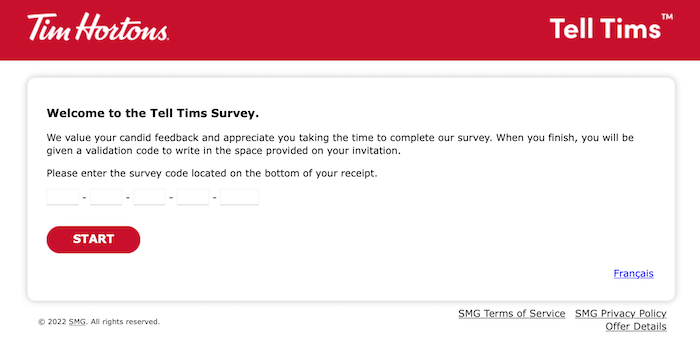
2. Improve Your Customer Service
It’s important to note that customer service differs from the customer experience. CX means every interaction a customer has with your brand, while customer service refers to interactions between a customer and employees when there’s a problem.
Unsurprisingly, then, boosting your customer service delivery can have a positive effect on your overall CX. How do you improve customer service, though? Here are some ideas.
- According to research by Khoros, 77 percent of customers expect customer support teams to share information so they don’t need to repeat themselves. Make sure you properly integrate your customer support processes using, for example, customer relationship management (CRM) software.
- Use chatbots: The Khoros research shows that 79 percent of customers enjoy chatting to customer service reps through these apps.
- Identify your most loyal customers. Reward them with exclusive discounts and special offers to encourage new transactions.
Here’s an example of a chatbot from Dropbox. Users can follow the step-by-step instructions or, if the chatbot can’t answer their questions, they can speak to a service representative or try other resources:
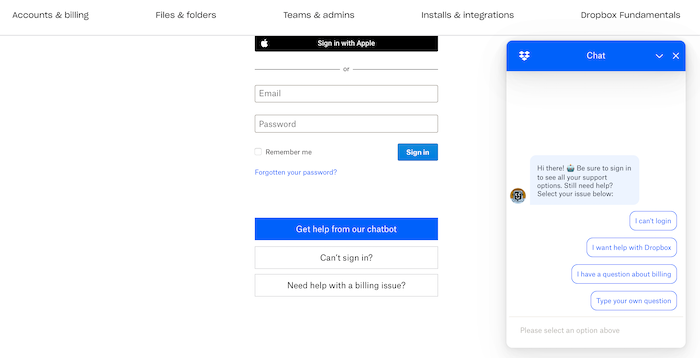
Improve customer service by offering various quick, simple, and effective ways to reach your team.
3. Make Conversions Easier
Zendesk’s research shows that 65 percent of customers are looking for quick, easy transactions. What does this mean?
Well, if you’re an e-commerce store, this means customers want a straightforward checkout experience. Let me give you some tips for speeding up the process.
- Provide a guest checkout option so there’s no need for someone to create an account to buy something.
- Offer multiple ways to pay, such as PayPal or mobile wallets like Apple Pay.
- Make your shipping and delivery costs transparent.
- Reduce the number of checkout screens where possible.
Are you a service provider? Then you want to ensure your sales process is seamless.
- Offer a free trial to nurture customers along the sales funnel.
- Explain your sales process upfront so customers know what to expect.
- Schedule a sales call so you can get the information you need from customers to solve their problems and resolve any hesitancies.
- Offer clear packages and transparent pricing structures tailored to various customers’ requirements.
Monday.com, for example, has a very clear pricing structure.
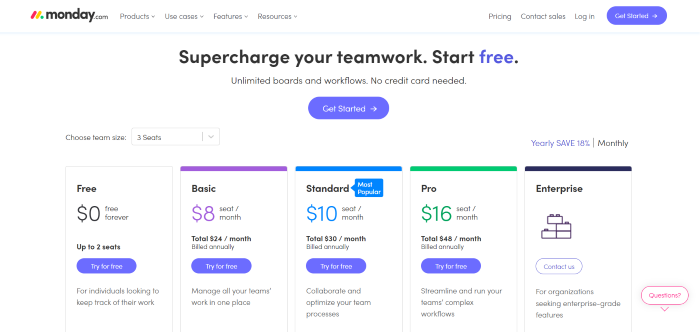
What’s more, it only takes a few steps to get started with a free account so prospects can experience the software before committing to a paid package:
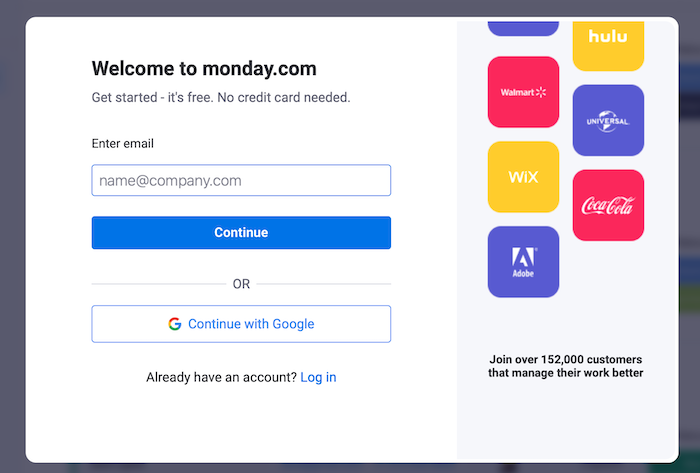
Impress your customers and boost CX by creating a seamless, user-friendly sales experience.
4. Personalize Customer Interactions
Earlier I touched on how personalization goes a long way to help boost customer acquisition and retention. How do you personalize customer interactions, though? Here’s what you can do:
- Build customer profiles so you know who your ideal customer is. Once you determine your audience base, you can segment your customers into groups to send them relevant marketing materials tailored to their personal preferences.
- Take an omnichannel approach. According to Zendesk’s research, companies with higher CX scores deliver consistent, reliable experiences across all mediums, from in-store shopping to buying products through a mobile app.
- Use the data you collect from customers to personalize surveys and try to follow up on survey responses.
Don’t forget the power of email, either. Retarget lapsed customers with personalized incentives, and send loyal customers recommendations based on their shopping history.
5. Empower Your Employees to Take Action
Who do your customers interact with? Your employees. If customers aren’t happy with your employees, there’s a risk they’ll abandon your brand completely.
What’s the answer? Empower your employees. Give them the tools they need to resolve queries, by:
- Asking employees for their feedback. Do they feel they have the resources necessary to deliver a great service, or are they feeling frustrated?
- Resolving identified pain points. Maybe you could streamline manual processes by updating your CRM software, or you could improve contact center protocols.
- Finally, empowering your employee, for example, maybe they could offer a discount to incentivize a new customer.
Customer Experience Case Study: Gymshark
Gymshark, an international fitness brand, excels at employee engagement.
How? Because employees have pretty significant authority to resolve disputes, and they’re very engaged with customers online.
For one thing, they have a dedicated Gymshark Help social media account to answer queries, proactively engage customers, and improve the customer experience.
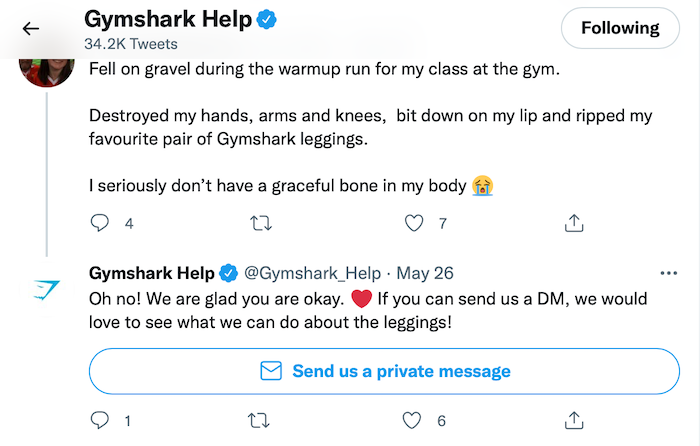
Their employees are entrusted to offer real solutions, which make customers feel valued at every stage of the buyer’s journey—even after the sale.
Does it pay to give employees freedom over CX delivery? Absolutely: Operating in over 180 countries and still growing, Gymshark knows how delivering great customer experiences can boost ROI.
Frequently Asked Questions About Customer Experiences
We’ve covered why customer experiences matter and how you might improve your CX, but let me give you some key takeaways.
How do you improve customer experiences?
Learn who your customers are and how they interact with your business. Once you understand the buyer’s journey, you can equip your employees to meet their needs and exceed their expectations.
What are the main components of customer experiences?
Promoting a customer-focused culture, ensuring you’re easy to do business with, measuring customer satisfaction, and delivering on your promises all contribute to the customer experiences that individuals have with your business.
How do you track the customer experience?
Get honest customer feedback and track CX metrics at each stage of the buyer’s journey using tools to measure your churn rate, customer effort score, retention rate, and net promoter score.
What makes a good customer experience?
Great customer experience starts with your staff. Give them the knowledge they need to manage your buyers, and you’re on track to impress your customers.
Conclusion: Improving the Customer Experience Is Crucial to Business Growth
Without customers, you won’t boost your ROI and your company won’t get off the ground, so you need to prioritize customer experiences.
To perform customer experience optimization successfully, help your staff nurture individuals along the buyer’s journey. Monitor key customer experience metrics along the way, and don’t be afraid to ask customers what you’re doing right—and where you’re falling behind.
Need extra help with the online customer experience? Check out my consulting services.
What do you think makes a great CX?
Did you miss our previous article...
https://consumernewsnetwork.com/technology-news/the-keys-to-success-with-amazon-advertising






